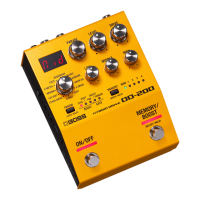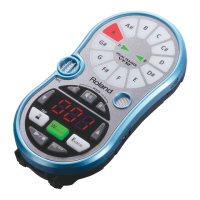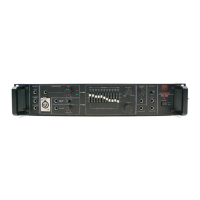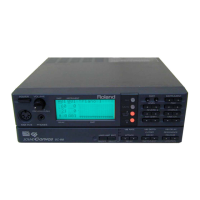30 QUICK GUIDE
7. Tryk på variation [1], [2], [3] eller [4] for at skifte til mere eller mindre komplekst
[INTRO] akkompagnement.
8. Spil en akkord på keyboardet.
9. Skærmbilledet viser navnet på akkorden på displayet.
10. Tryk på [START/STOP] knappen for at starte rytmen. Knappen lyser og BK-3 begynder
at spille.
11. Prøv at spille andre akkorder og lyt til akkompagnementet.
12. Aktiver [AUTO FILL IN] knappen så denne lyser.
Ved skift til andre variations mønstre, så vil BK-3 lave en kort overgang inden nye
variation overtager.
Playing Back Rhythms
25
6. Press the VARIATION [1], [2], [3] or [4] button to select the
complexity of the INTRO pattern.
For example press the VARIATION [3].
The VARIATION button pressed at the step 6. lights and the
VARIATION button pressed at the step 4. ashes to indicate the
verse complexity that will be played back at the end of the Intro
pattern.
7. Play a chord on the keyboard.
8. The main page displays the name of the last chord the
BK-3 recognized:
9. Press the [START/STOP]/[*/,] button to start rhythm
playback.
The [START/STOP]/[ */, ] indicator lights and the BK-3 starts playing
back the introductory phrase.
10. Play dierent chords on the keyboard and listen to the
eect this has on the rhythm.
11. Switch on the [AUTO FILL IN] button (it lights).
This means that when you select a dierent VARIATION pattern,
the BK-3 will play a transition (ll-in) before switching to the new
pattern.
12. Press a VARIATION [1], [2], [3] or [4] button to select a
more complex or a simpler accompaniment.
• If you press it before the last beat of the current measure, the ll-in
starts immediately and lasts until the end of the current measure,
then the newly selected VARIATION pattern is played back.
• • If you press the desired VARIATION button on the last beat of a bar,
the ll-in starts at the next downbeat and lasts an entire bar. Only
then will the BK-3 switch to the newly selected VARIATION pattern.
13. If necessary, you can change the rhythm’s tempo:
• Press the TEMPO [] or [] button to decrease or increase the
tempo
• Press the [TAP TEMPO] button at least three times at the desired
tempo.
The BK-3 calculates the intervals between your presses and sets the
corresponding tempo value.
MEMO
Simultaneously press the TEMPO [] and [] buttons
(“STANDARD”) to return to the rhythm’s preset tempo.
TIPS
You can press and hold the [TAP TEMPO] button to lock the
tempo setting (see p. 39).
14. Press the [ENDING] / [ & ] button to end rhythm playback
with a suitable closing section.
You could also stop playback simply by pressing the [START/STOP]/
[ */, ] button or by releasing all keys on the keyboard (see “[SYNC
START] / [ + ]” p. 22).
While rhythm or SMF song playback is stopped, the [TAP TEMPO]
button ashes to indicate the selected tempo.
Playing Back Rhythms
25
6. Press the VARIATION [1], [2], [3] or [4] button to select the
complexity of the INTRO pattern.
For example press the VARIATION [3].
The VARIATION button pressed at the step 6. lights and the
VARIATION button pressed at the step 4. ashes to indicate the
verse complexity that will be played back at the end of the Intro
pattern.
7. Play a chord on the keyboard.
8. The main page displays the name of the last chord the
BK-3 recognized:
9. Press the [START/STOP]/[*/,] button to start rhythm
playback.
The [START/STOP]/[ */, ] indicator lights and the BK-3 starts playing
back the introductory phrase.
10. Play dierent chords on the keyboard and listen to the
eect this has on the rhythm.
11. Switch on the [AUTO FILL IN] button (it lights).
This means that when you select a dierent VARIATION pattern,
the BK-3 will play a transition (ll-in) before switching to the new
pattern.
12. Press a VARIATION [1], [2], [3] or [4] button to select a
more complex or a simpler accompaniment.
• If you press it before the last beat of the current measure, the ll-in
starts immediately and lasts until the end of the current measure,
then the newly selected VARIATION pattern is played back.
• • If you press the desired VARIATION button on the last beat of a bar,
the ll-in starts at the next downbeat and lasts an entire bar. Only
then will the BK-3 switch to the newly selected VARIATION pattern.
13. If necessary, you can change the rhythm’s tempo:
• Press the TEMPO [] or [] button to decrease or increase the
tempo
• Press the [TAP TEMPO] button at least three times at the desired
tempo.
The BK-3 calculates the intervals between your presses and sets the
corresponding tempo value.
MEMO
Simultaneously press the TEMPO [] and [] buttons
(“STANDARD”) to return to the rhythm’s preset tempo.
TIPS
You can press and hold the [TAP TEMPO] button to lock the
tempo setting (see p. 39).
14. Press the [ENDING] / [ & ] button to end rhythm playback
with a suitable closing section.
You could also stop playback simply by pressing the [START/STOP]/
[ */, ] button or by releasing all keys on the keyboard (see “[SYNC
START] / [ + ]” p. 22).
While rhythm or SMF song playback is stopped, the [TAP TEMPO]
button ashes to indicate the selected tempo.
Playing Back Rhythms
25
6. Press the VARIATION [1], [2], [3] or [4] button to select the
complexity of the INTRO pattern.
For example press the VARIATION [3].
The VARIATION button pressed at the step 6. lights and the
VARIATION button pressed at the step 4. ashes to indicate the
verse complexity that will be played back at the end of the Intro
pattern.
7. Play a chord on the keyboard.
8. The main page displays the name of the last chord the
BK-3 recognized:
9. Press the [START/STOP]/[*/,] button to start rhythm
playback.
The [START/STOP]/[ */, ] indicator lights and the BK-3 starts playing
back the introductory phrase.
10. Play dierent chords on the keyboard and listen to the
eect this has on the rhythm.
11. Switch on the [AUTO FILL IN] button (it lights).
This means that when you select a dierent VARIATION pattern,
the BK-3 will play a transition (ll-in) before switching to the new
pattern.
12. Press a VARIATION [1], [2], [3] or [4] button to select a
more complex or a simpler accompaniment.
• If you press it before the last beat of the current measure, the ll-in
starts immediately and lasts until the end of the current measure,
then the newly selected VARIATION pattern is played back.
• • If you press the desired VARIATION button on the last beat of a bar,
the ll-in starts at the next downbeat and lasts an entire bar. Only
then will the BK-3 switch to the newly selected VARIATION pattern.
13. If necessary, you can change the rhythm’s tempo:
• Press the TEMPO [] or [] button to decrease or increase the
tempo
• Press the [TAP TEMPO] button at least three times at the desired
tempo.
The BK-3 calculates the intervals between your presses and sets the
corresponding tempo value.
MEMO
Simultaneously press the TEMPO [] and [] buttons
(“STANDARD”) to return to the rhythm’s preset tempo.
TIPS
You can press and hold the [TAP TEMPO] button to lock the
tempo setting (see p. 39).
14. Press the [ENDING] / [ & ] button to end rhythm playback
with a suitable closing section.
You could also stop playback simply by pressing the [START/STOP]/
[ */, ] button or by releasing all keys on the keyboard (see “[SYNC
START] / [ + ]” p. 22).
While rhythm or SMF song playback is stopped, the [TAP TEMPO]
button ashes to indicate the selected tempo.
Playing Back Rhythms
25
6. Press the VARIATION [1], [2], [3] or [4] button to select the
complexity of the INTRO pattern.
For example press the VARIATION [3].
The VARIATION button pressed at the step 6. lights and the
VARIATION button pressed at the step 4. ashes to indicate the
verse complexity that will be played back at the end of the Intro
pattern.
7. Play a chord on the keyboard.
8. The main page displays the name of the last chord the
BK-3 recognized:
9. Press the [START/STOP]/[*/,] button to start rhythm
playback.
The [START/STOP]/[ */, ] indicator lights and the BK-3 starts playing
back the introductory phrase.
10. Play dierent chords on the keyboard and listen to the
eect this has on the rhythm.
11. Switch on the [AUTO FILL IN] button (it lights).
This means that when you select a dierent VARIATION pattern,
the BK-3 will play a transition (ll-in) before switching to the new
pattern.
12. Press a VARIATION [1], [2], [3] or [4] button to select a
more complex or a simpler accompaniment.
• If you press it before the last beat of the current measure, the ll-in
starts immediately and lasts until the end of the current measure,
then the newly selected VARIATION pattern is played back.
• • If you press the desired VARIATION button on the last beat of a bar,
the ll-in starts at the next downbeat and lasts an entire bar. Only
then will the BK-3 switch to the newly selected VARIATION pattern.
13. If necessary, you can change the rhythm’s tempo:
• Press the TEMPO [] or [] button to decrease or increase the
tempo
• Press the [TAP TEMPO] button at least three times at the desired
tempo.
The BK-3 calculates the intervals between your presses and sets the
corresponding tempo value.
MEMO
Simultaneously press the TEMPO [] and [] buttons
(“STANDARD”) to return to the rhythm’s preset tempo.
TIPS
You can press and hold the [TAP TEMPO] button to lock the
tempo setting (see p. 39).
14. Press the [ENDING] / [ & ] button to end rhythm playback
with a suitable closing section.
You could also stop playback simply by pressing the [START/STOP]/
[ */, ] button or by releasing all keys on the keyboard (see “[SYNC
START] / [ + ]” p. 22).
While rhythm or SMF song playback is stopped, the [TAP TEMPO]
button ashes to indicate the selected tempo.
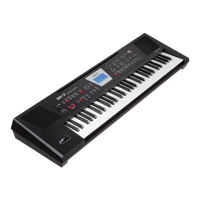
